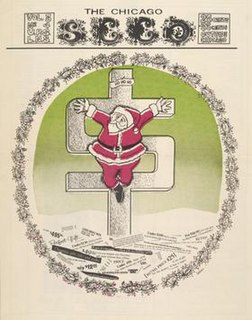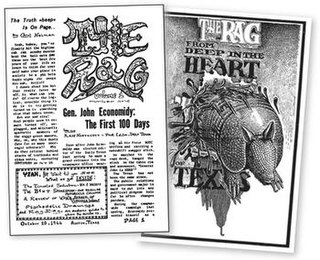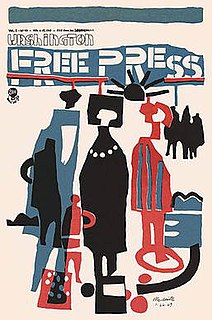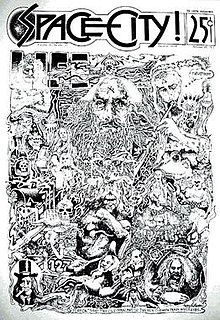Related Research Articles

Fifth Estate (FE) is a U.S. periodical, based in Detroit, Michigan, begun in 1965, and presently with staff members across North America who connect via the Internet. Its editorial collective sometimes has divergent views on the topics the magazine addresses but generally shares anarchist, anti-authoritarian outlook and a non-dogmatic, action-oriented approach to change. The title implies that the periodical is an alternative to the fourth estate.

The terms underground press or clandestine press refer to periodicals and publications that are produced without official approval, illegally or against the wishes of a dominant group. In specific recent Asian, American and Western European context, the term "underground press" has most frequently been employed to refer to the independently published and distributed underground papers associated with the counterculture of the late 1960s and early 1970s in India and Bangladesh in Asia, in the United States and Canada in North America, and the United Kingdom and other western nations. It can also refer to the newspapers produced independently in repressive regimes. In German occupied Europe, for example, a thriving underground press operated, usually in association with the Resistance. Other notable examples include the samizdat and bibuła, which operated in the Soviet Union and Poland respectively, during the Cold War.

The Underground Press Syndicate (UPS), later known as the Alternative Press Syndicate (APS), was a network of countercultural newspapers and magazines formed in mid-1966 by the publishers of five early underground papers: the East Village Other, the Los Angeles Free Press, the Berkeley Barb, The Paper, and Fifth Estate. As it evolved, the Underground Press Syndicate created an Underground Press Service, and later its own magazine. For many years the Underground Press Syndicate was run by Tom Forcade, who later founded High Times magazine.

The San Diego Door, was an underground newspaper that throve from January 1968 to August 1974 in San Diego and San Diego County, Southern California.

Seed was an underground newspaper launched by artist Don Lewis and Earl Segal, owner of the Molehole, a local poster shop, and published biweekly in Chicago, Illinois from May 1967 to 1974; there were 121 issues published in all. Disagreements between Lewis and Segal led to its purchase by Harry Dewar, a graphic designer and Colin Pearlson, a photographer, who thought it had commercial potential. Lester Dore took over the art direction when Don Lewis moved to New York to work for Screw magazine. Skeets Millard, a young photographer and community organizer who was publishing the Chicago edition of Kaleidoscope, joined the Seed staff in 1969, at a time when all of the original founders were gone and there was no one working on the paper who had been there more than 12 months; Mike Abrahamson was running the paper in Abe Peck's absence. Jim Roslof, Karl Heinz-Meschbach, Paul Zmiewski, Skip Williamson, Jay Lynch, Peter Solt, and other 60s artists contributed to what was called one of the most beautiful underground press publications of its time.

The Rag was an underground newspaper published in Austin, Texas from 1966–1977. The weekly paper covered political and cultural topics that the conventional press ignored, such as the growing antiwar movement, the sexual revolution, gay liberation, and the drug culture. The Rag encouraged these political constituencies and countercultural communities to coalesce into a significant political force in Austin. As the sixth member of the Underground Press Syndicate and the first underground paper in the South, The Rag helped shape a flourishing national underground press. According to historian and publisher Paul Buhle, The Rag was "one of the first, the most long-lasting and most influential" of the Sixties underground papers. In his 1972 book, The Paper Revolutionaries, Laurence Leamer called The Rag "one of the few legendary undergrounds."
The Columbus Free Press is an alternative journal published in Columbus, Ohio since 1970. Founded as an underground newspaper centered on anti-war and student activist issues, after the winding down of the Vietnam War it successfully made the transition to the alternative weekly format focusing on lifestyles, alternative culture, and investigative journalism, while continuing to espouse progressive politics. Although published monthly, it has also had quarterly, bi-weekly and weekly schedules at various times in its history, with plans calling for a return to a weekly format by the end of 2014.

The Washington Free Press was a biweekly radical underground newspaper published in Washington, DC, beginning in 1966, when it was founded by representatives of the five colleges in Washington as a community paper for local Movement people. It was an early member of the Underground Press Syndicate. Starting in December, 1967 they shared a three-story house in northwest Washington with the Liberation News Service, the Washington Draft Resistance Union, and a local chapter of the anti-draft group Resistance. A print shop was in the basement, and other activist groups used the space and got their mail there. The paper's original founders and editors included Michael Grossman, Arthur Grosman and former State Department computer programmer William Blum, but the staff went through many changes and by 1969 nobody on the paper was even acquainted with any of the original founders.

Quicksilver Times was an antiwar, counterculture underground newspaper published in Washington, DC. Its first issue was dated June 16, 1969, with Terry Becker Jr., a former college newspaper editor and reporter for the Newhouse News Service, the main instigator in the founding group of antiwar activists. It ran for 3 years, with its final issue appearing in Aug. 1972. Publication was irregular and during the latter part of its run it was publishing once every 3 weeks. It was a member of the Liberation News Service and the Underground Press Syndicate. Quicksilver Times was one of several anti-government underground papers of the period now known to have been infiltrated by government informants.
Willamette Bridge was an underground newspaper published in Portland, Oregon from June 7, 1968 to June 24, 1971. In the spring of 1968, several groups of people in Portland were discussing starting an "underground" newspaper in Portland, similar to the Los Angeles Free Press or the Berkeley Barb. They were partially motivated by a frustration with the reporting in the mainstream press, which was still supporting the Vietnam war, opposing progressive movements like the United Farmworkers Union, and showed no understanding at all of the growing "Counterculture" and its music, dress and mores. On the other hand, they saw many things going on in the city that were positive, but isolated- Antiwar activity at Reed College, "Hippies" gathering around Lair Hill park, the progressive wing of the Democratic Party gathering strength, craft stores and head shops opening around town, local bands like The Great Pumpkin and The Portland Zoo giving concerts. A newspaper could bring these groups together and break the information monopoly of the daily papers.

Philadelphia Free Press was a 1960s era underground newspaper published biweekly in Philadelphia, Pennsylvania from 1968 to 1972. Originally launched at Temple University in May 1968 as the monthly Temple Free Press, it separated from Temple and became the Philadelphia Free Press in September 1968.

Space City! was an underground newspaper published in Houston, Texas from June 5, 1969 to August 3, 1972. The founders were Students for a Democratic Society veterans and former members of the staff of the Austin, Texas, underground newspaper, The Rag, one of the earliest and most influential of the Sixties underground papers. The original editorial collective was composed of Thorne Dreyer, who had been the founding "funnel" of The Rag in 1966; Victoria Smith, a former reporter for the St. Paul Dispatch; community organizers Cam Duncan and Sue Mithun Duncan; and radical journalists Dennis Fitzgerald and Judy Gitlin Fitzgerald.
Pittsburgh Fair Witness was a radical counterculture underground newspaper published in Pittsburgh, Pennsylvania from 1970 to 1973. The first 9 monthly issues were published starting in February 1970 under the title Grok. Beginning with vol. 1, no. 10 the title was changed to Pittsburgh Fair Witness and the paper shifted to publication once every three weeks; starting with the Dec. 3-17, 1971 issue it published on a biweekly schedule until its demise with vol. 4, no. 6. The PFW was staff-owned and published by a collective that called itself "The Commune." An editorial published in the May 26, 1972 issue under the heading "Our Rap" gives the paper's statement of purpose:
"The Fair Witness is published by a non-profit collective and is dedicated to the worldwide movement of people to control themselves—the movement to break down the authoritarian systems of government that are denying us our basic freedoms, that are responsible for needless genocidal wars, the perpetration of minority discrimination, the pollution of our environment and our bodies, the high concentration of power among the wealthy classes, exploitation of the individual, etc. The paper is dedicated to the struggle of all peoples to gain back the right to their own lives, the struggle to raise the consciousness of the world as a whole, the struggle to become independently productive through a working knowledge of the tools at our disposal. As a local paper our most important function concerns the movement here in western Pennsylvania."
The Big Us was a radical underground newspaper published in Cleveland, Ohio starting in September, 1968, appearing biweekly in tabloid format. Its politics reflected the views of SDS. Editors were Carol Cohen McEldowney, a 25-year-old SDS organizer and Cleveland welfare caseworker, and Carole Close, an antiwar activist. The paper's headquarters were in a church coffeehouse/youth center called The Outpost, near the Case Western Reserve University campus. McEldowney left in May 1969 to work in an antiwar GI coffeehouse in South Carolina, and starting with the issue of Oct. 14, 1969 the paper changed its name to Burning River News, commemorating a famous incident in which the toxic waste on the surface of the Cuyahoga River in downtown Cleveland caught fire.
Tuesday's Child was a short-lived counterculture underground newspaper published in Los Angeles, California, USA, starting on November 11, 1969. Self-described on its masthead as "An ecumenical, educational newspaper for the Los Angeles occult & underground," it was founded by Los Angeles Free Press reporter Jerry Applebaum and a group of Freep staffers, including Alex Apostolides, who left en masse after disagreements with Art Kunkin to found their own paper. It was edited by Chester Anderson and published weekly from an office in Hollywood in a tabloid format, selling for 25 cents. Never achieving the success or circulation of its crosstown rival, the Free Press, it quickly attained a degree of notoriety in and out of the underground with its coverage of the Charles Manson case. One issue featured an image of a crucified Charles Manson on the cover, and another issue had a photograph of Manson on the cover proclaiming him "Man of the Year."

Old Mole was a radical New Left oriented underground newspaper published in Cambridge, Massachusetts from September 1968 to September 1970. Old Mole was continued by a second volume titled The Mole, which published five issues from November 1970 to April 1971. Printed biweekly in a 16-page tabloid format, Old Mole was based for most of its existence in a storefront and basement office on Brookline Street in Central Square. Selling for 15 cents, 47 issues were published in all, with press runs averaging 8000 to 10,000 copies. Subscriptions were free to prisoners and soldiers.
Arthur Glick Kunkin was an American journalist, political organizer, machinist and New Age esotericist best known as the founding publisher and editor of the Los Angeles Free Press.

Leviathan was a New Left radical underground newspaper published in a tabloid newspaper format and distributed through the underground press network in the US in the years 1969-1970. Fairly serious in content with a focus on radical organizing issues, it was loosely aligned with the SDS movement. The first issue was dated March, 1969, with two editorial offices in New York, where Carol Brightman, Beverly Leman, and Kathy McAfee were listed on the first masthead, later to be joined by a number of others including Marge Piercy and Sol Yurick; and San Francisco, where the collective included Peter Booth Wiley, Carole Deutch, Danny Beagle, Matthew Steen, Bob Gavriner, Al Haber, Bruce Nelson, Todd Gitlin and David Wellman. Part of the inspiration for the paper was a desire to fill the gap created by the demise of the influential New Left organ Studies on the Left, and the core group included people from the antiwar newsletter Viet Report.

GI Coffeehouses were a consequential part of the anti-war movement during the Vietnam War era, particularly the resistance to the war within the U.S. military. They were mainly organized by civilian anti-war activists as a method of supporting antiwar and anti-military sentiment among GIs, but many GIs participated as well. They were created in numerous cities and towns near U.S. military bases throughout the U.S as well as Germany and Japan. Due to the normal high turnover rate of GIs at military bases plus the military's response which often involved transfer, discharge and demotion, not to mention the hostility of the pro-military towns where many coffeehouses were located, most of them were short-lived, but a few survived for several years and "contributed to some of the GI movement's most significant actions". The first GI coffeehouse of the Vietnam era was set up in January 1968 and the last closed in 1974. There have been a few additional coffeehouses created during the U.S. led wars in Iraq and Afghanistan.
References
- ↑ "Renaissance Roots: Gathering of the Tribes on Crow Road" by Suzy Prozanski. Fair Family News, December, 2008. Retrieved March 22, 2011.
- ↑ About this newspaper: The Augur Chronicling America, Library of Congress. Retrieved March 22, 2011.
- ↑ "At This End of the Oregon Trail: The Eugene Augur, 1969-1974" by Peter Jensen, Voices from the Underground, ed. Ken Wachsberger (Mica Press, 1993).
| | This article about an Oregon newspaper is a stub. You can help Wikipedia by expanding it. |